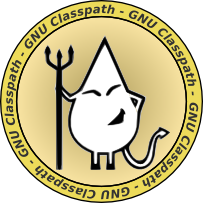
A JAR file is a package file format typically used to aggregate many Java class files and associated metadata and resources into one file for distribution.

GNU Classpath is a free software implementation of the standard class library for the Java programming language. Most classes from J2SE 1.4 and 5.0 are implemented. Classpath can thus be used to run Java-based applications. GNU Classpath is a part of the GNU Project. It was originally developed in parallel with libgcj due to license incompatibilities, but later the two projects merged.

Apache Ant is a software tool for automating software build processes for Java applications which originated from the Apache Tomcat project in early 2000 as a replacement for the Make build tool of Unix. It is similar to Make, but is implemented using the Java language and requires the Java platform. Unlike Make, which uses the Makefile format, Ant uses XML to describe the code build process and its dependencies.

The cron command-line utility is a job scheduler on Unix-like operating systems. Users who set up and maintain software environments use cron to schedule jobs, also known as cron jobs, to run periodically at fixed times, dates, or intervals. It typically automates system maintenance or administration—though its general-purpose nature makes it useful for things like downloading files from the Internet and downloading email at regular intervals.

glob is a libc function for globbing, which is the archetypal use of pattern matching against the names in a filesystem directory such that a name pattern is expanded into a list of names matching that pattern. Although globbing may now refer to glob -style pattern matching of any string, not just expansion into a list of filesystem names, the original meaning of the term is still widespread.
Maven is a build automation tool used primarily for Java projects. Maven can also be used to build and manage projects written in C#, Ruby, Scala, and other languages. The Maven project is hosted by The Apache Software Foundation, where it was formerly part of the Jakarta Project.

Object REXX is a high-level, general-purpose, interpreted, object-oriented (class-based) programming language. Today it is generally referred to as ooRexx, which is the maintained and direct open-source successor to Object REXX.
In computer programming, an entry point is the place in a program where the execution of a program begins, and where the program has access to command line arguments.
In computing, Java Web Start is a deprecated framework developed by Sun Microsystems that allows users to start application software for the Java Platform directly from the Internet using a web browser. The technology enables seamless version updating for globally distributed applications and greater control of memory allocation to the Java virtual machine.
pkg-config is software development tool that queries information about libraries from a local, file-based database for the purpose of building a codebase that depends on them. It allows for sharing a codebase in a cross-platform way by using host-specific library information that is stored outside of yet referenced by the codebase. This indirection allows the codebase to build on a host without encoding host-specific library information in the codebase.
EAR is a file format used by Jakarta EE for packaging one or more modules into a single archive so that the deployment of the various modules onto an application server happens simultaneously and coherently. It also contains XML files called deployment descriptors which describe how to deploy the modules.
In software engineering, a WAR file is a file used to distribute a collection of JAR-files, JavaServer Pages, Java Servlets, Java classes, XML files, tag libraries, static web pages and other resources that together constitute a web application.

A portable application, sometimes also called standalone software, is a computer program designed to operate without changing other files or requiring other software to be installed. In this way, it can be easily added to, run, and removed from any compatible computer without setup or side-effects.

CMake is a free, cross-platform, software development tool for building applications via compiler-independent instructions. It also can automate testing, packaging and installation. It runs on a variety of platforms and supports many programming languages.
The Java class loader, part of the Java Runtime Environment, dynamically loads Java classes into the Java Virtual Machine. Usually classes are only loaded on demand. The virtual machine will only load the class files required for executing the program. The Java run time system does not need to know about files and file systems as this is delegated to the class loader.
The Simple API for Grid Applications (SAGA) is a family of related standards specified by the Open Grid Forum to define an application programming interface (API) for common distributed computing functionality.
The Java Platform Module System specifies a distribution format for collections of Java code and associated resources. It also specifies a repository for storing these collections, or modules, and identifies how they can be discovered, loaded and checked for integrity. It includes features such as namespaces with the aim of fixing some of the shortcomings in the existing JAR format, especially the JAR Hell, which can lead to issues such as classpath and class loading problems.
Java Native Access (JNA) is a community-developed library that provides Java programs easy access to native shared libraries without using the Java Native Interface (JNI). JNA's design aims to provide native access in a natural way with a minimum of effort. Unlike JNI, no boilerplate or generated glue code is required.
The Java Development Kit (JDK) is a distribution of Java technology by Oracle Corporation. It implements the Java Language Specification (JLS) and the Java Virtual Machine Specification (JVMS) and provides the Standard Edition (SE) of the Java Application Programming Interface (API). It is derivative of the community driven OpenJDK which Oracle stewards. It provides software for working with Java applications. Examples of included software are the Java virtual machine, a compiler, performance monitoring tools, a debugger, and other utilities that Oracle considers useful for Java programmers.
The Java Desktop Integration Components (JDIC) project provides components which give Java applications the same access to operating system services as native applications. For example, a Java application running on one user's desktop can open a web page using that user's default web browser, but the same Java application running on a different user's desktop would open the page in Opera . Initially the project supports features such as embedding the native HTML browser, programmatically opening the native mail client, using registered file-type viewers, and packaging JNLP applications as RPM, SVR4, and MSI installer packages. As a bonus, an SDK for developing platform-independent screensavers is included. Most of the features provided by JDIC were incorporated into the JDK starting with version 1.6. As a result, the development of the project has come to an end.







